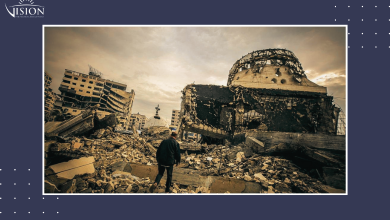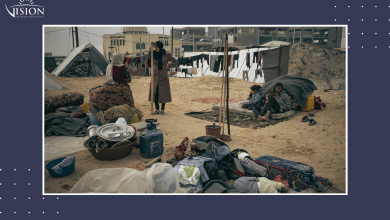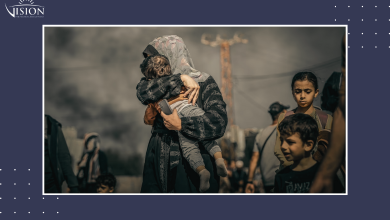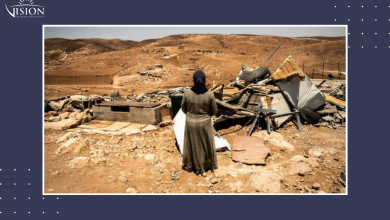Summary of Settler and Occupation Forces Violations: May 2025 Report
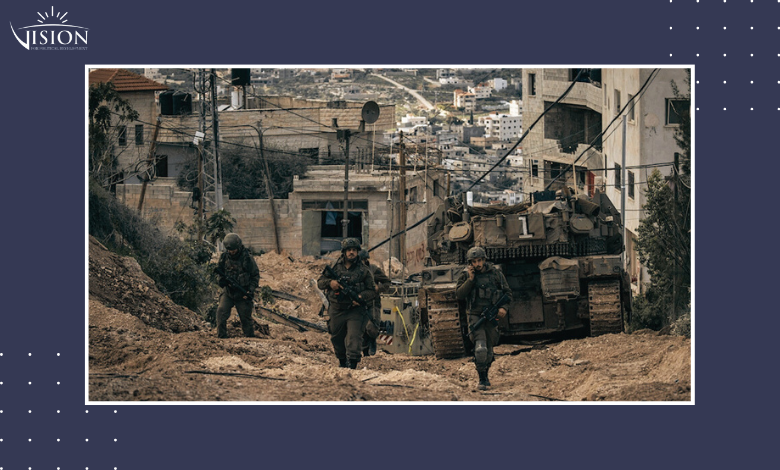
The following summary reviews the most notable attacks by the occupation army and settlers against Palestinian citizens and their lands during the month of May 2025. This report is based on information from reports by the Palestinian Monitoring Group affiliated with the Negotiations Affairs Department of the Palestine Liberation Organisation, the United Nations Office for the Coordination of Humanitarian Affairs (OCHA), the Wall and Settlement Resistance Authority, and Peace Now. settler
Genocidal Onslaught on the Gaza Strip
Since March 18, 2025, the Israeli occupation has resumed its war of extermination in the Gaza Strip and intensified its bombardment from land, air and sea across the Strip, while expanding its ground operations. This has coincided with the closure of all crossings for nearly 90 days, from March 2, until the end of May. The genocide, which has been ongoing since 7 October 2023, has resulted in the martyrdom of 54,084 Palestinians, including 16,854 children and 12,400 women, while 123,308 others were injured. Among the martyrs are 931 children under the age of 1 year, including 356 children who were born and killed during the conflict. Since the attacks resumed last March; 3,924 Palestinians have been killed and 11,267 others wounded. It should be noted that the toll does not include the martyrs who died in the northern Gaza Strip, which has been inaccessible since May 23.
On May 22, the Israeli authorities informed the Nadia Al-Asir Association of the death of a Palestinian prisoner from Gaza (aged 33) a year and a half after he was arrested at the Sde Teman camp on December 13, 2023. He had been arrested along with members of his family from their home in the Gaza Strip on December 7, 2023.
Since the beginning of May, 28 aid workers have been killed, an average of one per day. Since October 7, 2023, 452 aid workers have been killed, including 314 United Nations staff members, and the number of journalists killed has risen to 221.
Amid the steady deterioration of humanitarian conditions in the Gaza Strip and the worsening acute shortage of food, water and medicine, with more than 2 million Palestinians facing catastrophic conditions as a result of the ongoing blockade, and just three days after very limited aid entered the Strip at the end of May, a new Israeli plan emerged to distribute aid through an institution established with the support of American companies working in the field of security and logistics, in four distribution centres, three of which are in the south of the Strip and one in the Netzarim crossing, which separates the south of the Strip from the north. The United Nations Office for the Coordination of Humanitarian Affairs (OCHA) expressed its rejection of the new military-style aid distribution system, stressing that it is not in line with humanitarian principles, endangers the lives of civilians, and is incapable of meeting their needs or preserving their dignity.
The Israeli plan aims to reformulate the relief work methodology in line with its security and military objectives, as well as to serve its efforts to undermine the role of international organisations in the field of humanitarian work. Reports indicate that Israeli forces targeted civilians as they attempted to obtain food from the aforementioned centres, resulting in the deaths of 13 civilians and the injury of 108 others.
During the last third of this month, the occupation army issued several evacuation orders from areas in the governorates of northern Gaza, Gaza, Deir al-Balah, Khan Yunis and Rafah, bringing the total area prohibited for access for military purposes or subject to evacuation orders since March 18, to 81% of the Gaza Strip through 31 evacuation orders.
Reports show that the damage caused by the bombing and illegal occupation operations in the Strip affected about 81% of the total agricultural land area. Farmers are unable to access 78% of this land due to displacement orders and military occupation control, particularly in the governorates of Rafah and northern Gaza, where access to all agricultural land is impossible. Damage was also caused to 83% of agricultural wells, leading to a halt in local food production, which had accounted for 10% of Gaza’s economy before the genocide.
During the period covered by the report, Israel continued to target bakeries and soup kitchens. On May 21, the occupation army targeted a bakery in the centre of Gaza City, killing 10 civilians. Later that same day, occupation aircraft bombed another bakery in Khan Yunis, killing civilians. A mill and a bakery in Khan Yunis and Gaza were also bombed a few days after the bakeries were bombed.
Al-Awda Hospital, the only hospital still partially functioning in northern Gaza despite the harsh conditions, has also been repeatedly targeted by Israeli airstrikes. As part of the systematic targeting of health services, 6 hospitals, 20 health centres and 27 medical points located in areas subject to evacuation orders have been destroyed.
Key statistics on Violations by the Occupation in the West Bank and Jerusalem
For the 131st day, the occupation continues its military operation in the northern West Bank since January 21, with 33,000 displaced persons still prevented from returning to their homes in Tulkarm and Jenin. This comes in conjunction with the continuation of demolition operations in refugee camps in the Tulkarm governorate, as the Israeli authorities allowed the residents of 20 buildings, or about 50 families, to enter the Tulkarm camp to retrieve their belongings before the planned demolition operations were carried out, within a time limit of no more than three hours. These buildings are among a list of 58 houses that were scheduled for demolition on May 1. The occupation army designated a specific route to enable residents to reach the camp, while soldiers fired at citizens, journalists and Red Crescent crews as they attempted to enter the camp. In the Nour Shams camp, 48 buildings were scheduled for demolition, while the Tulkarm governor’s office estimated that around 50 houses had been demolished since May 1.
Reports indicate that approximately 670 families from the eastern neighbourhood of Jenin camp have been displaced once again as a result of Israeli military operations in the area. According to UNRWA estimates, more than 7,000 families comprising 33,000 Palestinians remain in a state of forced displacement, including 10,700 from Jenin camps, 10,500 from Nour Shams camp, and 12,200 from Tulkarm camp.
On May 22, the occupation forces ended a 9-day military operation in the towns of Broqin and Kfar al-Dik in Salfit, imposing severe restrictions on the movement of Palestinian citizens, while settlers continued to be present in the vicinity of the two towns under the protection of Israeli forces. The occupation army closed the two main gates to the city of Salfit, forcing Palestinians to use unpaved alternative routes, which exacerbated the suffering of the population, increased transportation costs, and disrupted access to basic services, including education and healthcare. Waste collection services in both Broqin and Kfar al-Dik were suspended during the operation, and the municipalities’ waste collection trucks were confiscated. During the raid, the army raided 6 schools and caused material damage.
Martyrs and Wounded:
During this month, 18 citizens were martyred, including 2 children and 1 prisoner. The Nablus governorate recorded the highest number of martyrs with 6 each, followed by the Tubas governorate with 5 martyrs. Among the martyrs were 8 citizens killed by the Israeli army in assassinations and 4 others during raids on Palestinian cities and villages. At least 118 citizens were wounded, including 23 children, a journalist and a citizen with special needs.
Since the beginning of the year, the occupation has killed 118 Palestinians in various parts of the West Bank, including 23 children. The highest percentage of martyrs was concentrated in the northern West Bank governorates: Jenin, Tubas, Tulkarm, Qalqilya, Nablus and Safit, accounting for 90% of the total martyrs in the West Bank.
Arrests and Raids on Residential Areas:
The occupation forces arrested 699 citizens in the West Bank and Jerusalem, including 33 children and 7 women. The arrests were concentrated in the city of Hebron with 134 arrests, followed by Tulkarm with 88 arrests, Ramallah with 77 detainees, Nablus with 74 detainees, and Salfit with 68 detainees. The rest of the arrests were distributed between Jerusalem, Qalqilya, Tubas, Jenin, Bethlehem, and Jericho.
According to data provided by the Israeli Prison Service to the organisation ‘HaMoked’, the number of Palestinian prisoners in Israeli prisons reached 10,068, including 3,577 administrative detainees without trial. The figures do not include prisoners from Gaza who were arrested after October 7, 2023.
The occupation army carried out 1,349 raids on scattered Palestinian residential areas in the West Bank and Jerusalem governorates, concentrated in Ramallah with 208 raids, followed by Nablus with 201 raids. The rest of the raids were distributed across the governorates of Jerusalem, Jenin, Tubas, Tulkarm, Qalqilya, Salfit, Jericho, Bethlehem and Hebron.
Demolition of Homes and Structures:
Since March 1, occupation forces have demolished 121 Palestinian homes and structures across the occupied West Bank, with most of them concentrated in the Hebron governorate, with 56 homes and structures. 48 notices were also issued for the demolition of Palestinian structures or the suspension of construction on the pretext of lack of permits, most of them in the Ramallah and Al-Bireh governorate with 21 notices, followed by Salfit with 18 notices.
Since the beginning of 2025, Israeli authorities have demolished 727 Palestinian structures, 65% of which were demolished on the grounds that they lacked building permits. The Israeli authorities deliberately refuse to approve structural plans for Palestinian communities located in Area C, prompting Palestinians to build without permits to keep pace with population growth or migration to Areas A and B, which constitute 36% of the West Bank’s area and are home to 86% of the West Bank’s total population. In Jerusalem, 50 of the 80 targeted structures were demolished by their owners after they received demolition orders and threats of fines on the pretext of lacking building permits. The occupation army also demolished 17 structures as a punitive measure, resulting in the displacement of 20 families comprising 79 individuals.
Land Confiscation and Bulldozing:
During the period covered by the report, the occupation authorities seized 48 dunums of land in Salfit, Nablus and Qalqilya through seven military orders, targeting 13,117 dunums of land in the village of Broqin in Salfit. In Nablus, they targeted 2,224 dunums of land in the village of Burin with the aim of establishing a military tower, 4,821 dunums of land in Hawara with the aim of establishing a security fence, 2,374 dunums of land in Awarta with the aim of establishing a security road, and 7,311 dunums of land in the villages of Qabalan and Beita with the aim of establishing a buffer zone around the Afit, 4 dunums of land in the village of Deir Sharaf for the purpose of establishing a military tower, and 14,917 dunums of land in the villages of Farata, Jit and Tal in Qalqilya and Nablus for the purpose of establishing a buffer zone around the Havat Gilat outpost.
The occupation forces bulldozed dozens of dunams of citizens’ land in the occupied West Bank governorates, particularly in Jenin, Tulkarm and Nour Shams camps, where they bulldozed and destroyed infrastructure. Occupation soldiers and settlers also uprooted approximately 1,068 olive trees in Hebron, Salfit, Ramallah, Tulkarm and Nablus.
Settler Attacks:
During this month, 321 cases of attacks by settlers on Palestinian citizens and their property were recorded, including raiding and cultivating agricultural land to take control of it or destroying Palestinian crops and trees, systematic attacks on Palestinian villages and towns, shooting at houses and burning vehicles, as well as stealing and confiscating citizens’ property.
Since the beginning of 2025, reports have documented 591 incidents of attacks by settlers, resulting in 223 Palestinians being injured, meaning that the average number of injuries resulting from settler attacks per month reached 44, the highest rate recorded since 2005, according to the United Nations Office for the Coordination of Humanitarian Affairs (OCHA).
Settlement Activity:
During May, the occupation authorities examined 26 structural plans aimed at expanding settlements in the West Bank and Jerusalem, approving 16 of them, while depositing 10 other plans. The March plans targeted 1,673 Palestinian lands for the construction of 3,451 permanent housing units.
In 2025, the West Bank is witnessing an unprecedented escalation in Israeli settlement activity, with the ‘Higher Planning Council’ scheduled to discuss on May 7, the approval of the construction of 1,588 new housing units, including 1,388 units in the ‘Kadumim’ settlement. This plan targets the area east of the settlement and south of the Palestinian village of Jit, approaching the settlement outpost of ‘Havat Gilad’ with the aim of creating a continuous geographical settlement corridor, thereby hindering any possibility of Palestinian expansion or construction in the village of Jit.
Over the past 2 months, 2 tenders have been announced for the construction of 296 units in the Kiryat Arba settlement near Hebron, and 2 others for the construction of 8 units in the Givat Binyamin settlement. A tender was also issued for the construction of a hotel with at least 180 rooms in the Ouz Fagoun settlement outpost south of Bethlehem, which was officially converted into a tourist centre in May 2022. In addition, a tender was announced for the construction of 14 industrial and commercial buildings in the industrial zone of the Ma’ale Adumim settlement, and another tender for a solar energy farm in the Har Menuh area south of Hebron. In February, tenders were published for the construction of 974 housing units in the Efrat settlement, bringing the total number of tenders since the beginning of 2025 to 1,278 new housing units in the settlements.
These tenders represent the implementation phase of the construction plans, following official approval by the Higher Planning Council, with the Land Administration inviting contractors to submit bids for building rights and marketing the projects.
At the same time, the state submitted a special request to the Israeli Supreme Court, announcing its intention to use a new land registration procedure, recently approved by the Ministerial Council, as a means of legalising illegal settlement construction on Palestinian land. This procedure allows the state to seize land that could not be declared ‘state land’ under previous procedures, which were based on an interpretation of Ottoman Land Law that only declared uncultivated land as state land. Now, the new measure allows any land, even cultivated land, to be registered in the name of the state if Palestinians cannot prove their ownership according to complex and difficult-to-verify criteria, threatening Palestinians with the loss of large areas of their land.
On the ground, this escalation is also evident in the settlers’ construction of approximately 139 new roads between mid-2023 and mid-2024, with a total length of 116.4 kilometres, most of which (about 65%) pass through private Palestinian land. These roads have been used to establish new settlement outposts and impose control over new areas and hills, with some even being built within Area B, which is under Palestinian civil control. Although these roads are not officially licensed, the state is investing millions of shekels in them, with the participation of the army and the Central Command, under security and military pretexts. The construction of these roads, along with the accompanying military activity, has led to the closure of many roads connecting Palestinian villages to their agricultural lands, reducing the Palestinian presence in Area C in favour of settlers, who now constitute the almost exclusive presence there.
On May 21, 2025, the Israeli government discussed approving the construction of 514 new housing units in 3 settlements: Eli, Alkan, and Ariel. This comes in the context of a shift in the council’s work since December 2024, when it began holding regular weekly meetings to advance housing projects in the settlements. This shift from quarterly to weekly meetings has led to the normalisation of construction in the occupied territories and accelerated its pace in an unprecedented manner. Since the beginning of 2025, the council has approved the construction of approximately 16,820 housing units, a record number never before seen in the West Bank.
Among these projects is the evacuation and reconstruction plan in the Ariel settlement, which aims to demolish old houses and build more housing units in their place.
On May 11, the Israeli Civil Administration began archaeological excavations at the Sebastia archaeological site west of Nablus, as part of a government plan to turn it into a ‘tourist settlement’ aimed primarily at the Israeli public and settlers. The Israeli government has allocated a huge budget of 32 million shekels for the years 2023-2025 to develop the site, including paving a direct access road and establishing a visitor reception centre. This investment is part of a broader government initiative to promote so-called ‘tourist settlements’ in the West Bank.
On May 22, 2025, the village of Al-Mughayer, east of Ramallah, which is home to hundreds of residents, began evacuating its homes under the pressure of escalating settler violence. Pastoral settlement outposts surrounded the village, and settlers seized large areas of land, preventing residents from accessing their fields and pastures and cutting off their livelihoods. The establishment of a new settlement outpost between the village homes was the final straw that prompted the residents to flee en masse. This comes amid Israel’s declared support for the settlers and statements by settler leaders confirming that their goal is the forced displacement of Palestinians from the area.
On another front, data from the Israeli Ministry of Finance reveals that in 2024, the government spent approximately 101 million shekels on private security companies to protect some 3,000 settlers living in Palestinian neighbourhoods in East Jerusalem, such as Silwan, the Muslim Quarter and Ras al-Amud. This includes the permanent stationing of security personnel in the settlers’ homes and accompanying them in all their movements. Since 1997, expenditures have reached more than 2.6 billion shekels, although these allocations were not previously included in the original budget but are added annually.
At the end of May 2025, the Israeli government decided to establish 22 new settlements in the West Bank, including 12 illegal outposts and farms that will be ‘legalised,’ 9 completely new settlements, and granting the existing settlement of ‘Naveh Barat’ independent status. This brings the number of settlements decided upon since the formation of the current government in December 2022 to 49 official settlements, with the start of procedures to legalise 7 additional outposts as neighbourhoods belonging to existing settlements. The new settlements are geographically distributed across the governorates of Jenin, Hebron, the Jordan Valley, Nablus, Ramallah and Jerusalem, reflecting Israel’s strategy of intensifying settlement activity throughout the West Bank.
NOTE: This text is adabted from original Arabic article.


